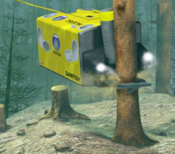Discovery’s Planet Earth series is so beautiful, I think it make my head a-splode. Just speechless. One second of footage of an orca striking a seal, blown out in time on high-speed cam to 47 seconds, like nothing you’ve ever seen. Birds of Paradise dancing so surreal they can’t be from this planet. Hyenas tracking impalas with a group intelligence like ESP. Throw away everything you thought you knew about nature programming. This raises the bar so high…
Environmentalism: Satan’s Work
Q: What’s worse, ignorance or apathy?
A: I don’t know and I don’t care.
Jerry Falwell is decrying global warming as “Satan’s attempt to redirect the church’s primary focus” from evangelism to environmentalism. “Naive Christian leaders,” in fact, have been duped—DUPED, I say—by dirty hippies like Al Gore.
Meanwhile, Mark Morford has an entertaining piece on the 13% of Americans who claim never to have heard of global warming. Think about that. Tens of millions of Americans. Never heard of it.
Reality is just crushing sometimes.
Unchained Goddess
1958 prototype for “An Inconvenient Truth?”
From the educational documentary “Unchained Goddess” produced by Frank Capra for Bell Labs for their television program “The Bell Telephone Hour.”
50 years of denial, and here we are.
Dirt Floors
J-School student David Gelles writes for the New York Times about green homeowners deploying mud, rather than wood, bamboo, or carpeting for their home flooring.
It is hardly a new or chic movement: millions of poor people around the globe use natural materials like dirt for their homes whether they want to or not. But with the growing environmental awareness in this country, Mr. Kahn said, there is greater interest in natural building materials like dirt.
Not without their problems, but can be made moisture resistant with beeswax and linseed oil, and more crack-resistant by adding paper pulp or fiber. They do sound gorgeous and comforting.
Block Out the Sun
Some scientists estimate that if we could prevent 1% of all sunlight from reaching the earth, we could offset the effects of all global warming that has taken place since the beginning of the industrial revolution. Global warming? No problem! Block out the sun!
While steering a recent UN report on warming away from the role of emissions, the US wants to include provisions for plans to install giant space mirrors in the atmosphere as “insurance.” Alternatives include floating bajillions of shiny balloons, or injecting the atmosphere with reflective droplets that would mimic the cooling effect of a massive volcanic eruption.
Of course it’s good to be thinking through all possibilities and preparing for last-ditch scenarios, but to emphasize post-facto band-aid solutions while de-emphasizing root causes is both foolhardy and arrogant. And therefore not surprising.
The Pingo Problem
Pingos are small Arctic and Sub-Arctic hills – sometimes above-ground, sometimes submerged. Some pingos are formed when warming water thaws layers of permafrost, allowing mounds of methane hydrate to emerge from the hard ground below. Remember, methane is a virulent greenhouse gas. Pingos are appearing with increasing frequency, and that’s not good. When pingos pop, they release methane, which heats up the atmosphere, which warms the oceans and thaws the permafrost, which spurs the formation of more pingos, leading to more methane release… From a comment at Salon.com
Mankind’s emissions will be the fuse, rapidly melting permafrost will be the detonator, and melting ocean methane hydate will be the bomb. … Unfortunately, mankind’s emissions are a much stronger trigger than past severe runaway global warming episodes, so the chain reaction will happen sooner, faster, and therefore will be much, much more severe.
Suddenly I’m thinking of pingos like some kind of skin rash on the face of the earth, or as the geological equivalent of buboes, pre-saging worsening health.
Sawfish
 Every time some short-thinking state decides it would be a great idea to dam up a river and swamp dozens (or hundreds) of square miles of forest land, a kazillion trees are drowned in the backwater. Drowned, but not necessarily wasted. Forests die beneath the chilly water, but remain perfectly preserved for many years, and their lumber is still usable. Until recently, it was not possible to harvest drowned forests.
Every time some short-thinking state decides it would be a great idea to dam up a river and swamp dozens (or hundreds) of square miles of forest land, a kazillion trees are drowned in the backwater. Drowned, but not necessarily wasted. Forests die beneath the chilly water, but remain perfectly preserved for many years, and their lumber is still usable. Until recently, it was not possible to harvest drowned forests.
Triton Logging has created a remote-control submersible called Sawfish. Wielding a pair of giant pincers and a 54-inch chainsaw, the craft grabs hold of a tree at the base, jams a balloon into its trunk and inflates it, and cuts through its trunk in a few seconds flat. The tree floats to the surface, where it’s dropped into a “bunk.” Waterlogged trees are hauled off by barge, hundreds at a time. Wired, in Reservoir Logs:
There are environmental advantages to the Sawfish method as well. Conventional aboveground harvesting contributes to deforestation, a cause of global warming that’s responsible for the release of 25 percent of the world’s CO2 emissions. But because underwater trees are already dead, cutting them down doesn’t worsen the situation. And with underwater logging, there are no unsightly clear-cuts and no spotted owls to worry about.
The supply of submerged trees is immense:
Most salvage loggers believe that reservoirs conceal 200 million to 300 million trees worldwide. “That’s a low estimate,†Godsall says. “We’re continually discovering reservoirs with trees in them. There’s one in Brazil called Tucurui with $1 billion worth of timber.â€
Green Cone
 Cooltools on the Solarcone Green Cone: “Regular composters are notoriously picky: no bones, no meat, no oil, no avocado pits or shells, no citrus peels, no dairy products. The Green Cone happily devours all that stuff, which means that pretty much all your kitchen waste can go in it, right now. File and forget.”
Cooltools on the Solarcone Green Cone: “Regular composters are notoriously picky: no bones, no meat, no oil, no avocado pits or shells, no citrus peels, no dairy products. The Green Cone happily devours all that stuff, which means that pretty much all your kitchen waste can go in it, right now. File and forget.”
This kind of thing should be standard-issue equipment on all new home construction. Downside (or upside, depending on your needs): Its breakdown of organic waste seems to be total – you don’t get any yummy composted soil out the other end (but click More to read the company’s response to my question on this).
Tagging Shark Fin Soup
oceana.org on shark fin soup:
Shark finning involves cutting off the shark’s fins while it is still alive, and then tossing the body back into to the sea, dead or dying. Finning only utilizes 2 – 5 percent of the entire animal, throwing away sources of protein and potential commercial and medicinal products. Up to 73 million sharks are killed every year to support the international shark fin market, threatening already overexploited shark populations around the world. Sharks are slow-growing and long-lived animals, and often their populations cannot bounce back from the incredible fishing pressure placed upon them for their fins. In fact, one-fifth of all shark species are considered threatened with extinction according to the World Conservation Union’s (IUCN) 2006 Red List of Threatened Species.
Oceana’s campaign to convince Amazon.com to remove shark fin soup has apparently been effective. The two pages I found on the site selling shark fin soup are both marked “This item is currently not available.”
Interestingly, the campaign seems to have been two-pronged — the usual email letter writing, as well as consumers using Amazon’s tagging and rating features to weigh in. Both items are currently ranked with just one out of five stars, and include tags like these:

The read/write web in action. Of course Amazon isn’t the world’s only purveyor of cruelty-generated food, but it is an important one.
Comment of the Year
This year’s Birdhouse Comment of the Year nod goes to reader BBT, who commented on the recent post More Plastic Than Plankton, re: the intractable mess caused by a century of plastic products making their way to the world’s oceans.
I chose BBT’s comment because, to me, it represented the apotheosis of Dan Gilmor’s citizen journalism credo, “Our readers know more than we do.” I read a couple of articles and watched a video on plastics in the ocean, while BBT has been in the trenches, removing the stuff and seeing the damage it causes with his own eyes and hands. Most weblog comments flesh out entries in a way that’s just not possible with traditional media; BBT’s comment did that extremeley well.
While I was at the Midway Atoll during the summer of 2001 I found it very disheartening to be on patrol for plastics. We had as an ecotourism organization (the midwayphoenix.com company) and a subcontractor to the Dept. of the Interior for maintainance of the island atoll must clean it up regularly. One time I remember heading from Sand Island (the main island of the Atoll) to Eastern and Spit islands to do shoreline cleanup. At times we had 20-30 *tons* of material to gather up on the shore. Those were light duty also. The volume of stuff in the ocean is flabbergasting to even those prepared for the shock of it. I remember seeing the small Albatros chicks dead and rotting in the nests from lack of food. Not that their parenting birds didn’t try. They simply mistook the plastics in the ocean for squid, and regurgitated that back to the chicks which promptly thought they were full but starved to death due to the plastics not passing out. What was often left in the nests were just a ball of small plastic items. Quite sad indeed.
